
Lookout Studio, known also as The Lookout, is a stone building located on the South Rim of the Grand Canyon, within Grand Canyon National Park in Arizona. It is part of the Grand Canyon Village Historic District, and is part of the Mary Jane Colter Buildings National Historic Landmark. It currently operates as a gift shop and observation station for visitors, with telescopes on its outdoor terrace. Lookout Studio was constructed by the Santa Fe Railway in 1914 and was established as a photography studio to compete with Kolb Studio. It is one of six buildings at the Grand Canyon that were designed by architect Mary Colter, along with Bright Angel Lodge, Hermit's Rest, Hopi House, Phantom Ranch, and Desert View Watchtower. Lookout Studio employs her signature rustic style of using jagged native rocks to imitate indigenous structures of the region and to blend in with the environment.
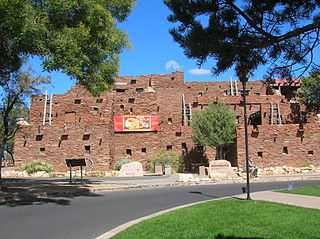
The Mary Jane Colter Buildings are four structures at Grand Canyon National Park designed by Mary Colter. Built between 1905 and 1932, the four buildings are among the best examples of Colter's work, and were influential in the development of an aesthetic for architecture to be used in America's National Park System. As a set, they were declared a National Historic Landmark in 1987.

Grand Canyon Village Historic District comprises the historic center of Grand Canyon Village, on the South Rim of the Grand Canyon in Grand Canyon National Park, Arizona. The district includes numerous landmark park structures, many of which are National Historic Landmarks themselves, or are listed on the National Register of Historic Places. The town design as a whole is also significant for its attention to integration with the Grand Canyon landscape, its incorporation of National Park Service Rustic design elements, and for the idiosyncratic design of park concessioner structures such as the El Tovar Hotel.
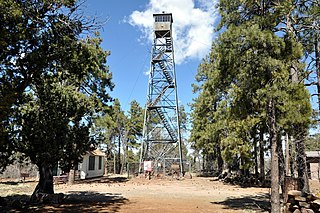
Mingus Lookout Complex is a fire tower lookout complex atop Mingus Mountain in Prescott National Forest, in Arizona. It was listed on the National Register of Historic Places in 1988.

The historical buildings and structures of Zion National Park represent a variety of buildings, interpretive structures, signs and infrastructure associated with the National Park Service's operations in Zion National Park, Utah. Structures vary in size and scale from the Zion Lodge to road culverts and curbs, nearly all of which were designed using native materials and regional construction techniques in an adapted version of the National Park Service Rustic style. A number of the larger structures were designed by Gilbert Stanley Underwood, while many of the smaller structures were designed or coordinated with the National Park Service Branch of Plans and Designs. The bulk of the historic structures date to the 1920s and 1930s. Most of the structures of the 1930s were built using Civilian Conservation Corps labor.
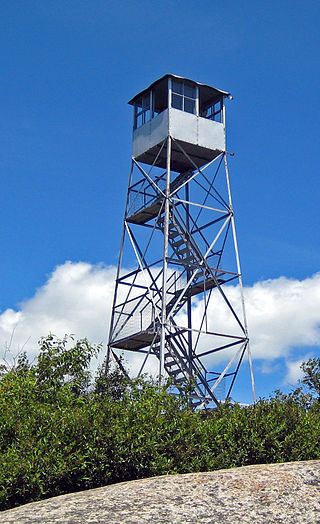
The Poke-O-Moonshine Mountain Fire Observation Station is a historic fire lookout tower on Poke-O-Moonshine Mountain at Chesterfield in Essex County, New York. The station and contributing resources include a 40-foot-tall (12 m), steel-frame lookout tower erected in 1917, a jeep trail that extends from the base of the mountain to a point below its summit, the remains of an observer's cabin possibly built by the Civilian Conservation Corps in 1936, and a spring house. The tower is a prefabricated structure built by the Aermotor Windmill Company.

The Copper Creek Guard Station was built by the Civilian Conservation Corps in 1935. It is located in a very remote area, near Black Canyon City, Arizona, United States. It was listed on the National Register of Historic Places in 1993 for its architecture. It was designed by the USDA Forest Service in Bungalow/Craftsman style. It served historically as a camp and as a government office. The NRHP listing included two contributing buildings on 4 acres (1.6 ha).
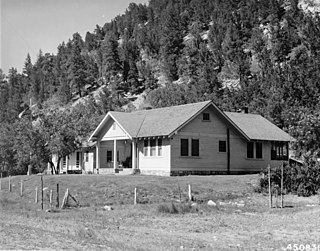
The Big Springs Ranger Station is a ranger station located in Kaibab National Forest near Big Springs, Arizona. The ranger station was built by the Civilian Conservation Corps in 1934. The complex includes a house, an office building, and a barn with an attached corral; while these are the only contributing structures to the district, it also includes a number of outbuildings. U.S. Forest Service architects designed the buildings in a Bungalow style characteristic of Forest Service architectural plans during the 1930s.
Architects of the National Park Service are the architects and landscape architects who were employed by the National Park Service (NPS) starting in 1918 to design buildings, structures, roads, trails and other features in the United States National Parks. Many of their works are listed on the National Register of Historic Places, and a number have also been designated as National Historic Landmarks.

Shadow Mountain Trail is a trail 4.8 miles (7.7 km) long on the east side of Shadow Mountain Lake, near Grand Lake, Colorado. It is also known as, or is associated with, Echo Mountain Trail, Lookout Mountain Trail and Pine Ridge Trail. The trail was rebuilt in 1930 by the National Park Service; trail design reflects NPS Naturalistic Design of the 1920s to 1940s.

The North Rim Road, Black Canyon of the Gunnison National Park, near Crawford, Colorado was built during 1933–38. It is an approximately five mile long roadway, with viewpoints and associated structures. It is recognized as a "designed landscape". It includes five overlooks over the Black Canyon of the Gunnison.
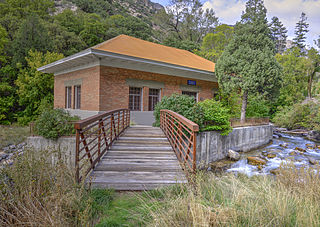
The Upper American Fork Hydroelectric Power Plant Historic District is a 1.5-acre (0.61 ha) historic district in American Fork Canyon in northeastern Utah County, Utah, United States, that is listed on the National Register of Historic Places (NRHP).

Cape Lookout Village Historic District is a national historic district located near Core Banks, Carteret County, North Carolina. It encompasses 20 contributing buildings 1 contributing site, and 6 contributing structures in Cape Lookout Village. The buildings include notable examples of Queen Anne and Bungalow / American Craftsman style architecture. The district includes two government complexes: the Cape Lookout Lighthouse Station and the Cape Lookout Coast Guard Station. In addition, 14 buildings, a long dock, and the circulation network, as well as the landscape in which these lie, compose the district. The buildings include the Life Saving Station (1888) and Boathouse, the Keeper's Quarters (1907), Luther Guthrie House, Gaskill-Guthrie House, Seifert-Davis House, Baker-Holderness House, the Bryant House, and the Carrie Arendell Davis House.

The McLemore Cove Historic District near Kensington, Georgia, about 3 miles (4.8 km) south of Chickamauga, Georgia, is a 50,141-acre (20,291 ha) historic district listed on the National Register of Historic Places. It includes 262 contributing buildings, 15 other contributing structures, 15 contributing sites, and a contributing object, as well as 327 non-contributing buildings and structures. It consists of the roughly triangular-shaped valley, McLemore Cove, between the ridge lines of Lookout Mountain on the west and Pigeon Mountain on the east.
The Carey Dome Fire Lookout is a fire lookout tower complex located in Nez Perce National Forest, 9 miles north of United States Forest Service Burgdorf Guard Station, near Burgdorf in Idaho County, Idaho. It was listed on the National Register of Historic Places in 1994.

The PS Knoll Lookout Complex is a fire lookout tower and accompanying cabin located in the Apache-Sitgreaves National Forest. It was constructed in the mid-1930s. The nine-acre site consists of 3 contributing buildings and 1 contributing structure. The buildings are a house, storage shed, and outhouse; the structure is the lookout tower. The lookout sits at an elevation of 8,045 feet (2,452 m), and rises to a height of 45.9 feet (14.0 m). It was constructed by the Aermotor Windmill Company in 1933.

The Guffey Butte–Black Butte Archeological District is a 14,000 acres (57 km2) historic district in southwestern Idaho, United States, that is listed on the National Register of Historic Places (NRHP). It includes numerous archeological sites in Ada, Canyon, Elmore, and Owyhee counties.
The Bluewater Lookout Complex, in Otero County, New Mexico near Weed, New Mexico was established in 1937. It was listed on the National Register of Historic Places in 1988. The listing included a contributing structure and two contributing buildings.

The Mangas Mountain Lookout Complex, on Mangas Mountain near Mangas, New Mexico, was built in 1934. It was listed on the National Register of Historic Places in 1988. The listing included one contributing building and one contributing structure.
















